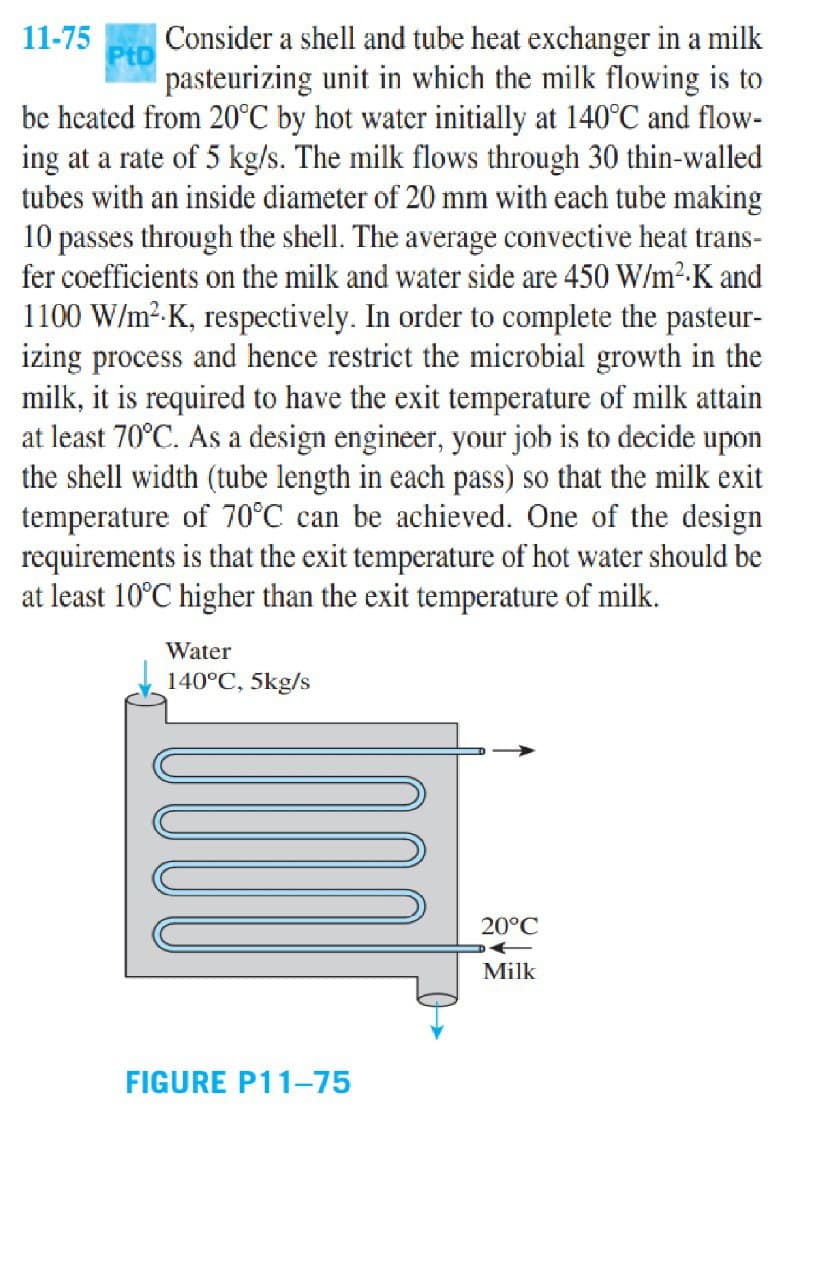11-75 PtD | Consider a shell and tube heat exchanger in a milk pasteurizing unit in which the milk flowing is to be heated from 20°C by hot water initially at 140°C and flow- ing at a rate of 5 kg/s. The milk flows through 30 thin-walled tubes with an inside diameter of 20 mm with each tube making 10 passes through the shell. The average convective heat trans- fer coefficients on the milk and water side are 450 W/m²-K and 1100 W/m²-K, respectively. In order to complete the pasteur- izing process and hence restrict the microbial growth in the milk, it is required to have the exit temperature of milk attain at least 70°C. As a design engineer, your job is to decide upon the shell width (tube length in each pass) so that the milk exit temperature of 70°C can be achieved. One of the design requirements is that the exit temperature of hot water should be at least 10°C higher than the exit temperature of milk.
11-75 PtD | Consider a shell and tube heat exchanger in a milk pasteurizing unit in which the milk flowing is to be heated from 20°C by hot water initially at 140°C and flow- ing at a rate of 5 kg/s. The milk flows through 30 thin-walled tubes with an inside diameter of 20 mm with each tube making 10 passes through the shell. The average convective heat trans- fer coefficients on the milk and water side are 450 W/m²-K and 1100 W/m²-K, respectively. In order to complete the pasteur- izing process and hence restrict the microbial growth in the milk, it is required to have the exit temperature of milk attain at least 70°C. As a design engineer, your job is to decide upon the shell width (tube length in each pass) so that the milk exit temperature of 70°C can be achieved. One of the design requirements is that the exit temperature of hot water should be at least 10°C higher than the exit temperature of milk.
Principles of Heat Transfer (Activate Learning with these NEW titles from Engineering!)
8th Edition
ISBN:9781305387102
Author:Kreith, Frank; Manglik, Raj M.
Publisher:Kreith, Frank; Manglik, Raj M.
Chapter10: Heat Exchangers
Section: Chapter Questions
Problem 10.32P
Related questions
Concept explainers
Heat Exchangers
Heat exchangers are the types of equipment that are primarily employed to transfer the thermal energy from one fluid to another, provided that one of the fluids should be at a higher thermal energy content than the other fluid.
Heat Exchanger
The heat exchanger is a combination of two words ''Heat'' and ''Exchanger''. It is a mechanical device that is used to exchange heat energy between two fluids.
Question

Transcribed Image Text:Consider a shell and tube heat exchanger in a milk
pasteurizing unit in which the milk flowing is to
be heated from 20°C by hot water initially at 140°C and flow-
ing at a rate of 5 kg/s. The milk flows through 30 thin-walled
tubes with an inside diameter of 20 mm with each tube making
10 passes through the shell. The average convective heat trans-
fer coefficients on the milk and water side are 450 W/m²-K and
11-75
1100 W/m²-K, respectively. In order to complete the pasteur-
izing process and hence restrict the microbial growth in the
milk, it is required to have the exit temperature of milk attain
at least 70°C. As a design engineer, your job is to decide upon
the shell width (tube length in each pass) so that the milk exit
temperature of 70°C can be achieved. One of the design
requirements is that the exit temperature of hot water should be
at least 10°C higher than the exit temperature of milk.
Water
140°C, 5kg/s
20°C
Milk
FIGURE P11-75
Expert Solution
This question has been solved!
Explore an expertly crafted, step-by-step solution for a thorough understanding of key concepts.
This is a popular solution!
Trending now
This is a popular solution!
Step by step
Solved in 3 steps with 3 images

Knowledge Booster
Learn more about
Need a deep-dive on the concept behind this application? Look no further. Learn more about this topic, mechanical-engineering and related others by exploring similar questions and additional content below.Recommended textbooks for you

Principles of Heat Transfer (Activate Learning wi…
Mechanical Engineering
ISBN:
9781305387102
Author:
Kreith, Frank; Manglik, Raj M.
Publisher:
Cengage Learning

Principles of Heat Transfer (Activate Learning wi…
Mechanical Engineering
ISBN:
9781305387102
Author:
Kreith, Frank; Manglik, Raj M.
Publisher:
Cengage Learning